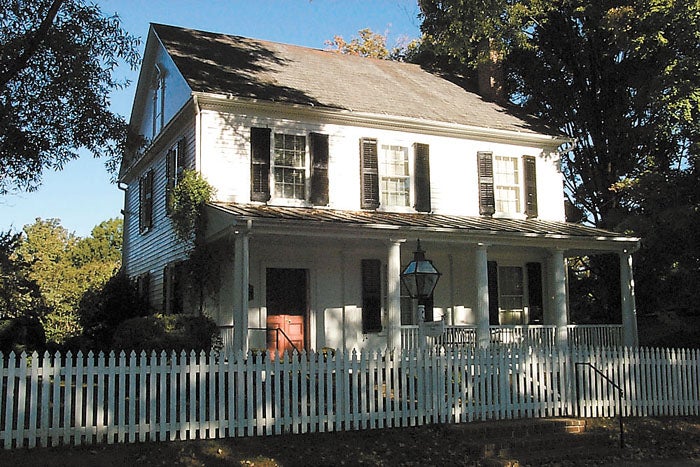People & Places Sunday, August 4
Published 12:00 am Sunday, August 4, 2019

- Utzman-Chambers House celebrates 200 years on August 11
Eagle family reunion today
Aug. 4 at St. Matthew Lutheran Church in the “hut” across the street from the church. 10:30 a.m. service at the church, covered dish dinner 12:30 p.m. Bring dishes, desserts and drinks.
James Elbert Hall reunion Aug. 10
Covered dish dinner. Drinks and eating supplies furnished. Mt. Pisgah Lutheran Church, Hwy. 127, Bethlehem, NC, Saturday, Aug. 10. Dinner at 1 p.m. Bring pictures or family history.
Salisbury-Rowan Newcomers
A club for everyone… Not just newcomers. Enjoy bridge games, dinner groups, movie outings, book clubs, community service and more. Check the website at salisburynewcomers.com
Lyme Disease support
TODAY — Aug. 4, 3-5 p.m. at St. John’s Lutheran Church, room 218, 200 W. Innes St. Info: Doug 704-785-5425, Elizabeth 704-636-3190, or Facebook: Celebration of Hope Piedmont NC Lyme Disease Support Group
200th anniversary of the Utzman-Chambers House
Save The Date: Sunday, Aug. 11, Utzman-Chambers House, 116 S. Jackson St. 4-6 p.m.
Rowan Museum invites you to celebrate the 200th anniversary of the Utzman-Chambers House.
Regency Period re-enactors and board members will greet guests, play period games with children, serve light refreshments, and share information about the house, the period, and the collection. The event is free and children of all ages are welcome.
Donations for the upkeep of the property are appreciated.
Rowan Redbuds
The Rowan Redbuds Garden Club met Thursday, July 25, in the Hurley Room at Rowan Public Library. President Carol Comer presided. If you are interested in visiting the club, call 704-633-2091 for more information.
Volunteer for Barnabas
Amid the talk about breaking the “school to prison pipeline” Center for Faith & the Arts sponsors the Class Act program at Henderson Alternative School and collaborates with St. John’s Lutheran Church in their Barnabas Connection program.
Barnabas is an after-school arts program for at risk students at Knox Middle School. Through arts programming and positive adult interaction the program provides a safe place for students who are facing challenges in their lives to express themselves and to find supportive adult companionship.
To learn more contact Nancy Gaines at ngainescfa@gmail.com or come to the introductory meeting on Aug. 22 at 2:30 p.m. at St. John’s Lutheran Church.
Kneeling Gardners
KANNAPOLIS — The Kneeling Gardeners met June 24 at Trinity United Methodist Church, hosting guest speaker Randy Cox from the Rowan County Beekeeper Association. He is a Rowan County Extension Master Gardener Volunteer and provided a program on bees.
85 percent of all flowering plants need help moving pollen between plants. One out of every three bites on your plate is owed to pollinators. There are over 200,000 species of cross pollinators. Pollination in the Piedmont is mostly by bees, approximately 70 percent. There are 20,000 species of bees worldwide.
Bees have been around over 100 million years. They are found in fossils and have survived the ice age. Beekeeping is the oldest form of agriculture. In the United States, the honeybee is responsible for $22 billion of our crop value.
In the 1940s there were 5 million colonies of bees. Today, there are 2.74 million colonies producing 178 million pounds of honey. Practically all colonies today are beekeeper managed. Bees only live six weeks, spending three weeks in the hive and three weeks foraging. A single colony will have 50,000-60,000 bees. Honeybees gather pollen on legs in “pollen baskets” and gather nectar in a special “honey stomach.”
Native bees improve pollination twice as much as will a honeybee. The bumble bee is a general pollinator. He flies early in cool weather but does not survive the winter. A carpenter bee bores holes in wood and slits in flowers. A squash bee is a fine-tuned pollinator depending on pollen from squash, cucumbers, melons, etc. and is many times more efficient. A blueberry bee forages mostly on blueberries. The Blue Orchard Mason Bee is small and found mostly on fruit blossoms. Other good pollinators are sweat bees, miner bees and cuckoo bees.
Since 2006 the average honeybee loss has been more than 30 percent per year. There is no single cause, but stress factors include climate change, habitat degradation, lawns with mulched areas, commercial transport such as moving bees from crop area to crop area plus the misuse of chemicals and pesticides that compromise bee health.
We need to create rural and urban habitat areas and plant a diversity of natural plants. Each household needs to strive for 75 percent native plants. Plant different colors, scents, and shapes. Bees like especially white, yellow, blue and purple. Let your garden carrots, dill, mustard and turnip greens go to flower for the bees.
The next meeting is 7 p.m. Sept. 23. Dennis Testerman will speak on land stewardship.



